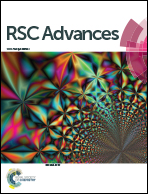Vibrational spectroscopy of isolated copper(ii) complexes with deprotonated triglycine and tetraglycine peptides
Abstract
The gas-phase vibrational predissociation spectra of deprotonated copper–triglycine ([Cu + G3-3H]−) and deprotonated copper–tetraglycine ([Cu + G4-4H]2−), a known water oxidation catalyst, are presented. Unambiguous determination of the coordination structure in these complexes is made by comparison of the experimental spectra with calculations. We found both complexes to have an approximately square planar geometry in which all the amide groups are deprotonated and coordinating to the Cu center. Our experimentally determined structure for [Cu + G3-3H]−, in which the terminal carboxylate and amine groups provide the additional coordination interaction, agrees with previous studies. However, the [Cu + G4-4H]2− complex is found to have the carboxylate group coordinated to the Cu center rather than NH2, as determined in previous solution-phase studies. Our results also highlight the sensitivity of the amidate C![[double bond, length as m-dash]](https://www.rsc.org/images/entities/char_e001.gif) O stretch frequencies to the charge and coordination environment in these complexes. The observed experimental frequencies alone are capable of providing qualitative information on the interactions present in these species.
O stretch frequencies to the charge and coordination environment in these complexes. The observed experimental frequencies alone are capable of providing qualitative information on the interactions present in these species.


 Please wait while we load your content...
Please wait while we load your content...